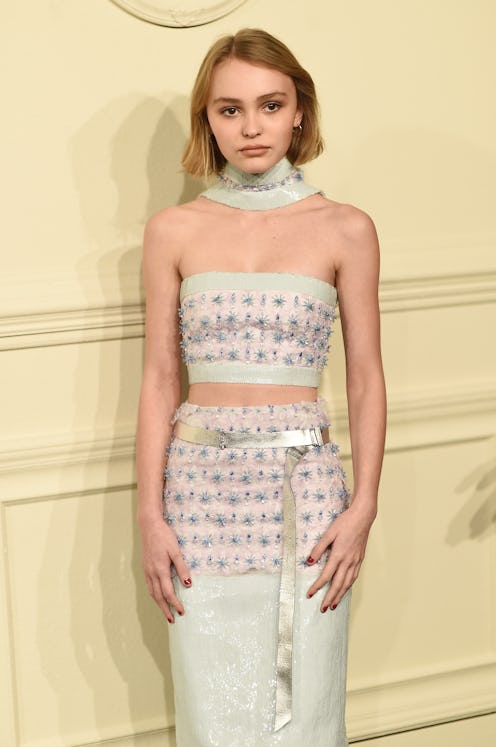Entertainment
Here’s Why Lily-Rose Depp’s New Role Is Important
Joining the legions of young women who follow in their father-performers' footsteps, Lily-Rose Depp has been cast in The Dancer , a film about the relationship between dancer Isadora Duncan (Depp) and Loie Fuller (Soko). You know the ones — Georgia May Jagger, Rumer Willis, Miley Cyrus, even Liv Tyler. The showbiz kids seem to have a leg up (or, to take the body metaphor a little further, a foot in the door), but they also have to cope with inevitable expectations based on their parents' performances. It's not Depp's first foray into screen by any means, but it is a pretty high-profile project that will also star Gaspard Ulliel.
In fact, the actors involved in the film are likely more recognizable names than the subjects themselves. Isadora Duncan was once one of the biggest figures in the dance community, but she's faded into relative obscurity as the art has continued to develop. Her name will still ring bells — and Isadora practitioners still emulate her style — but the character behind the name is perhaps not as well-known as she once was. Born in 1877 in San Francisco, Duncan was the daughter of a banker and amateur classicist with a fixation on ancient Greek culture and its contemporary resonance. This might be a historical quirk but for the profound impact it had on Duncan's dance. She carried that resonance into another medium. When she and her brother traveled to Paris, they went to the Louvre where he proceeded to draw each of the Greek vases in the museum's collection, according to the Isadora Duncan International Institute. Duncan would then translate those images into dance.
For someone who made her name with an inherently visual and present art, there are astonishingly few images of the dancer. Part of this is a function of the time — she grew up in an era before photographic technology had evolved to the level of portability and ubiquity that it has today. Yet there is one clip of her dancing that exists.
In the clip, Duncan swans around, improvising, for all of five seconds before she accepts the audience's applause with a bow. It exemplifies her Greek-influenced style and her penchant for embellishments. Much of the Isadora style involves a sinuous movement of the torso and arms; its form stands in sharp contrast to the rigor of ballet and complex technique. And perhaps even more notably — she's outside. Duncan's dancing emphasized humanism and nature, and her setting shows that philosophy of her dancing. She was suspicious of the camera, perhaps belying a deeper discomfort with signifiers of contemporaneity. "Her portrait and the sensation of her dancing would be rendered by countless artists in other media," writes Laura Jacobs at the London Review of Books, "But it turns out that the camera made her selfconscious."
To go with her fluid style, Duncan had a fondness for flowing Grecian garments that would prove her undoing. It was a fondness shared by her artistic partner Loie Fuller, who helped launch her career. The book Loie Fuller: Goddess of Light explains that Fuller had no formal dance training and no familiarity with classical art. Perhaps Duncan found a yin to her yang in Fuller, she who had grown up in and around museums. They shared a lack of rigor in their dance principles, which may have facilitated their efforts to shake up the dance world. There are no principles to reject if you never learned those principles in the first place, after all.
Duncan's dancing inspired countless disciples whose dance troupes still exist today. Even during her life, these pockets of Duncanites began to crop up in the form of Greek dance camps in the Catskill mountains or studios on the Champs-Elysées, as the New Yorker reported back in 1927. But that penchant for Greek classicism — for flowing robes and long neck scarves — brought about her sudden demise at age 50. In a morbid turn of events, her silk scarf became entangled in the spokes of a wheel of her car, tugging her out of the car and breaking her neck. Her famous last words, "Adieu, mes amis, je vais à la gloire!" — translating to "Farewell, my friends, I go to glory" — may have actually been "je vais à l'amour," alluding to a tryst with her driver.
It will be an exciting turn of events if Depp pulls a Natalie Portman and studies up on the mechanics of Duncan's school of dance à la Black Swan. Though Duncan isn't the central figure of The Dancer, she and Fuller co-pioneered the nouveau Grecian style that made them famous, so she's sure to be a central figure. Both women are fascinating figures in their own right, and their personal and professional relationships even more so. Adieu, mes amis, je vais au cinéma.
Image: Wikimedia Commons
